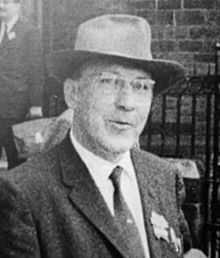Szolem Mandelbrojt
| Szolem Mandelbrojt | |
|---|---|
 Szolem Mandelbrojt | |
| Born |
10 January 1899 Warsaw, Congress Poland |
| Died |
23 September 1983 (aged 84) Paris, France |
| Residence | Poland, France, U.S. |
| Nationality | Polish |
| Fields | Mathematician |
| Institutions |
Université Lille Nord de France Collège de France Rice University |
| Alma mater |
University of Kharkiv Université Paris IV-Sorbonne |
| Doctoral advisor | Jacques Hadamard |
| Doctoral students |
Paul Malliavin Shmuel Agmon Hugh Brunk Vincent Cowling John Gergen Guy Johnson, Jr. Jean-Pierre Kahane Yitzhak Katznelson George Piranian Hans Jakob Reiter |
| Notes | |
|
He is the uncle of Benoît Mandelbrot. | |
Szolem Mandelbrojt (10 January 1899 – 23 September 1983) was a Jewish-Polish mathematician. He worked mainly in classical analysis; he was a student of Jacques Hadamard, and became Hadamard's successor as Professor at the Collège de France.
He was an early member of the Bourbaki group, taking part in some of its initial gatherings. In fact his direction was very different, as his publications show, with an interest in Dirichlet series, lacunary series, entire functions and other major topics in complex analysis and harmonic analysis. He is more accurately described as a follower of G. H. Hardy, and can be placed in the group containing Norbert Wiener and Torsten Carleman who were moderate modernisers of classical Fourier analysis. Shmuel Agmon, Jean-Pierre Kahane, Yitzhak Katznelson, and Paul Malliavin are among his students.
During World War II he was in the United States, in Houston at the Rice Institute from 1940, being one of many scientists helped by the programme of Louis Rapkine (1904–1948).
Benoît Mandelbrot was his nephew.
Selected works
Books
- with Jacques Hadamard: La série de Taylor et son prolongement analytique. 1926.[1]
- Modern researches on the singularities of functions defined by Taylor's series. 1927.[2]
- Séries de Fourier et classes quasi-analytiques de fonctions; leçons professées à l'lnstitut Henri Poincaré et à la Faculté des sciences de Clermont-Ferrand. 1935.
- Séries lacunaires. 1936.[3]
- Séries adhérentes régularisation des suites applications; leçons professées au Collège de France et au Rice Institute. 1952.[4]
- Fonctions entières et transformées de Fourier applications. 1967.
- Séries de Dirichlet; principes et méthodes. 1969.
- Dirichlet series. Principles and methods. 1972.
- Selecta / Szolem Mandelbrojt. 1981.
Articles
- with Floyd Edward Ulrich: "On a generalization of the problem of quasi-analyticity". Trans. Amer. Math. Soc. 52: 265–282. 1942. MR 0007015.
- "Quasi-analyticity and analytic continuation—a general principle". Trans. Amer. Math. Soc. 55: 96–131. 1944. MR 0009635.
- with Gerald R. MacLane: "On functions holomorphic in a strip region, and an extension of Watson's problem". Trans. Amer. Math. Soc. 61: 454–467. 1947. MR 0020142.
- "Analytic continuation and infinitely differentiable functions". Bull. Amer. Math. Soc. 54: 239–248. 1948. MR 0023877.
- with K. Chandrasekharan: "On solutions of Riemann's functional equation". Bull. Amer. Math. Soc. 65: 358–362. 1958. MR 0111727.
- "Les taubériens Généraux de Norbert Wiener". Bull. Amer. Math. Soc. 72, Part 2: 48–51. 1966. MR 0184008.
References
- ↑ Smail, L. L. (1928). "Review: La Série de Taylor et son Prolongement Analytique by J. Hadamard and S. Mandelbrojt". Bull. Amer. Math. Soc. 34 (1): 119–120.
- ↑ Widder, D. V. (1929). Review of Modern Researches on the Singularities of Functions Defined by Taylor's Series by S. Mandelbrojt. Bull. Amer. Math. Soc. 35 (3). pp. 409–410.
- ↑ Moore, C. N. (1938). "Review of La Réduction des Séries Alternées Divergentes et ses Applications by J. Ser and Séries Lacunaires by S. Mandelbrojt". Bull. Amer. Math. Soc. 44 (5): 313.
- ↑ Fuchs, W. H. J.. "Series adhérentes. Régularisation des suites. Applications. by S. Mandelbrojt". Bull. Amer. Math. Soc. 59 (4): 413–414.
External links
- O'Connor, John J.; Robertson, Edmund F., "Szolem Mandelbrojt", MacTutor History of Mathematics archive, University of St Andrews.
- Szolem Mandelbrojt at the Mathematics Genealogy Project
|